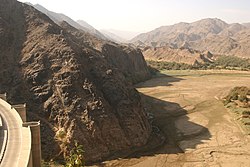|
Najran Province
Najran (Arabic: نجران Najrān) is a province of Saudi Arabia, located in the south of the country. It has an area of 149,511 km². Its capital is Najran. Najran is inhabited by the Yam tribe. A significant percentage of the province's inhabitants are Shia Ismaili.[2] The current governor of the region is Prince Jiluwi bin Abdulaziz Al Saud. EtymologySimilar to other ancient place names in Arabia, Najrān may have originally been the name of the whole oasis including all towns and villages. The old name of the ruins now known as "al-Ukhdūd", which may have been the central town, probably corresponds to Ramat. GeographyNajran contains three geographical areas. First, the flat area which lies in the middle of Najran. It has several valleys, the most famous of them being Najran’s valley. Second, the mountainous area which is in the west and the north. There the weather is moderate in summer. It has several parks shaded by nabk trees. It has important governorate centers: Habuna governorate, Badr El-Junoob governorate and Yadmah governorate. Many of the mountains are distinguished by granite rocks, where marble and granite are quarried,. Third, the sandy area which lies in the east and is a part of the Empty Quarter. It is extremely rich in oil and water. Governorates
Najran Valley DamNajran Valley Dam is considered to be one of the most important civil places in Najran Region because of its position and scenery.[citation needed] It is 35 km from Najran town. On this dam, there is a road 4.5 meters wide. It was built from concrete blocks, and has a system of water pipes which keeps the water cold. As-Saud WaterfallAs-Saud Waterfall is located in Najran, and can be seen from a considerable distance away.[citation needed] Population
Governors of Najran
Religious groups in NajranNajran, a fertile valley in what is now southwestern Saudi Arabia at the foot of mountains bordering the vast stretch of desert known as the Empty Quarter, was traditionally home to Christian and Jewish communities, in addition to Sulaymani Ismailis and Zaidis. Christians have been absent from Najran for some centuries, and the remaining Jewish community is Yemenite Jews that migrated to Najran and have left in 1949, following the establishment of the state of Israel. Najran's Zaidi community in 2008 numbers around 2,000.[4] The 2004 Saudi census put the number of inhabitants in Najran at around 408,000. Sulaymani Ismailis, widely believed to constitute a large majority of the Najrani population, share an identity based on historical, cultural, and religious roots. In Najran city, the Khushaiwa compound, with its Mansura mosque complex, is the spiritual capital of the Sulaymani branch of the Ismaili sect, one of two major strands of contemporary Ismailism. Most Ismailis in Najran belong to one of two tribes: Yam and the Hamdan. There are also some Sunnis of the Yam tribe, both recent converts as well as those who have adhered to Sunni Islam for centuries.[4] Ancient Christian communityNajran is known for being home to an ancient settlement of Christians in the Arabian peninsula. They signed the "Najran Pact" in the 7th century with the Islamic prophet, Muhammad, promising them fair treatment as "protected subjects" (dhimmi) of the newly conquered territories. The village is now abandoned.[5] CultureCuisineThe local dishes in Najran include:
Folk artsNajran has some folk arts including traditional clay techniques.[citation needed] The houses are built of light tan clay in the shape of a rectangle. On the other hand, Najran has different kinds of traditional dance. For example, Al-Zamil which is an enthusiastic kind of poetry refers to special occasion in which so many men share together in the middle of a circle formed by old men. The stanzas of Al-Zamil are chosen carefully to express the subject for the occasion. Furthermore, Al-Zamil is considered to express emotions, and some time for apologies. Al-Razffah describes a dance which is used for wedding, or for happy occasions. Choirs come into rows and they sing poetry. Al-Razffah has a special time and special voice.[citation needed] Between the two rows two men meet each other and they dance in specific movements holding stilettos or sticks in their hands. Also there is another art that is (Laa'bat Ateran) done by black men.[citation needed] Mass shootings of Ethiopian refugeesSince 2014, refugees have been killed after crossing the Saudi border by the Saudi Border Guard. Since 2023, at least several hundred Ethiopian refugees have been killed at the border between Yemen and the provinces Jazan, ʽAsir, and Najran. The Saudis also used explosive weapons.[6][7] See alsoReferences
External linksWikimedia Commons has media related to Najran Province.
|
||||||||||||||||||||||||||||||||||||||||||||||||||||||||||


